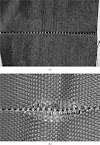Different Finishes Used in Textiles
With growing demands both in quality as well as properties some finishing techniques are used.
After weaving the fabric is in grey state i.e. unprocessed or unfinished which hasn't been dyed, bleached and processed. To add the required properties and quality some finishes are done.
To make a garment attractive to the customers then garments should have good appearance that appeal to customers to buy it. In this case there is no alternative of garment finishing treatment to give attractive look of garments.
The garment finishing processes can assist to a certain extent to fulfill the requirement of fast-moving fashion and to add functionality.
Garment finishing consists of a series of finishing operations performed in the garment to improve its aesthetics, handle and functional properties. Finishing treatment may be either mechanical or chemical in nature.
Let's see some of the additional processes done on the fabric as a value addition by imparting newer properties:
1. Easy Care Finish
It is an acknowledged fact that cotton garments ensure maximum comfort thanks to their suppleness and their capacity to absorb humidity. The weak point of cotton clothing is its tendency to crease easily, which makes care of such garments more difficult. The tendency to crease is due to the to partially amorphous structure of the cellulose.
2. Flame Retardant Finish
Flame retardants reduce the likelihood of a fire starting by improving the resistance to ignition of potential fire sources. When a fire does start, flame retardants reduce the flame spread and the rate of fire development, providing valuable extra time in the early stages of the conflagration to extinguish the fire or make an escape
3. Water Repellent Finish
The term waterproof refers to the finish that block interstices of fabric by forming a hydrophobic film on its surface thereby making it impermeable to air. The water repellent finish is permeable to air but not to water and so garments made from such treated fabric are comfortable to wear.
4. Soil Release Finish
A finish that increase the absorbency of a fabric, this finish allowed stains to leave the fabric faster, increase the wicking action for greater comfort in wear, which makes fabric dry-cleanable without significant loss of soil release properties and maintains brightness after respective repeated laundering.
5. Anti Bacterial Finish
Spores of fungi and bacteria exist everywhere and under hot and humid conditions. These microorganisms attack the natural fibres as well as the finishes applied to these and cause mildew and rotting damages. Natural fibers such as cotton are more susceptible than synthetics because their porous hydrophilic structure retains water, oxygen and nutrients, providing a perfect environment for bacterial growth.
Antimicrobials control, destroy or suppress the growth of microorganisms and their negative effects of odour, staining and deterioration on textile surface.
6. Wrinkle Resistant Finish (Wrinkle Free)
Wrinkle free resin finishing is a process to apply chemical resin onto fabrics functioning crosslinking between hydrogen bonds in order to enhance stability, on other words, fabrics are prevent to wrinkling. The ability of a fabric to recover to a definite degree is called crease recovery of the fabric.
Wrinkle free finishes are broadly used in the apparel industry to impart wrinkle-resistance to cellulosic materials such as cotton fabric.
7. Deodourizing Fragrances Finish
Deodorizing fragrance operates via a number of mechanisms.
– Inhibiting the enzymes responsible for producing malodour.
– Lowering the vapour pressure of malodour.
– Reducing the perception of the malodour.
Deodorizing fragrances prevent the build up of malodour during the wear or use of the treated textiles & keep the cotton textiles fresh when not in use.

















0 Comments
If you have any doubts, please don't hesitate to ask